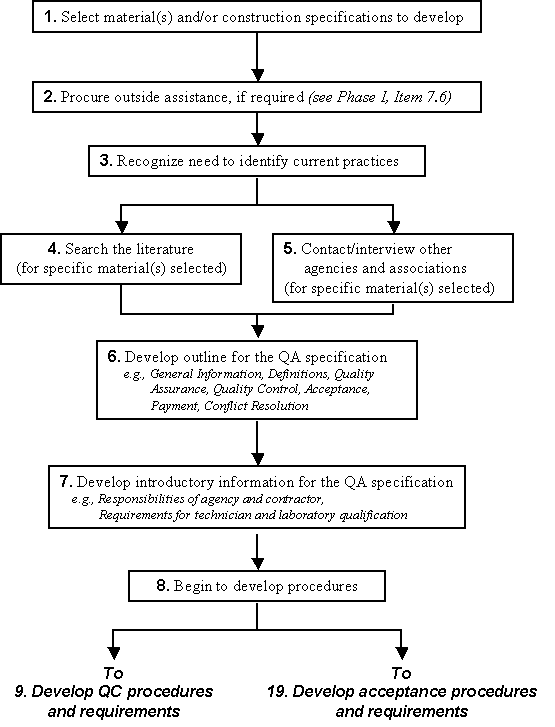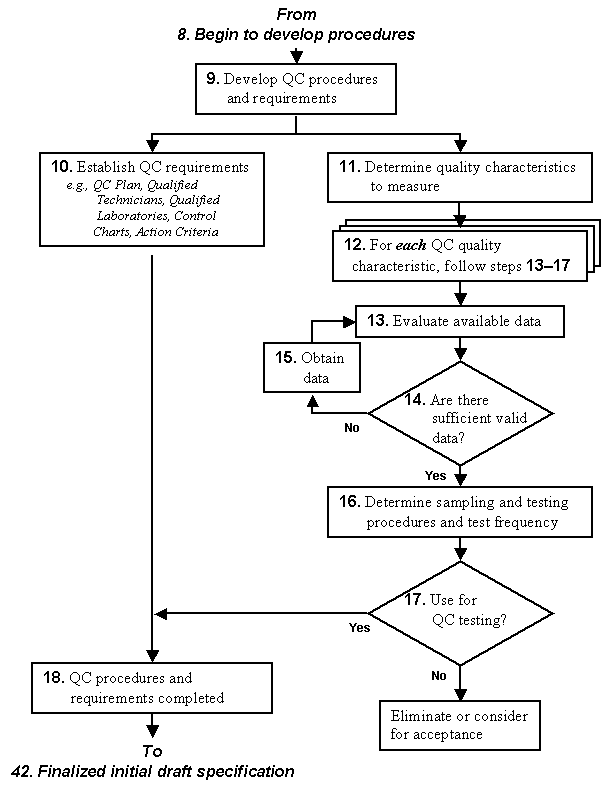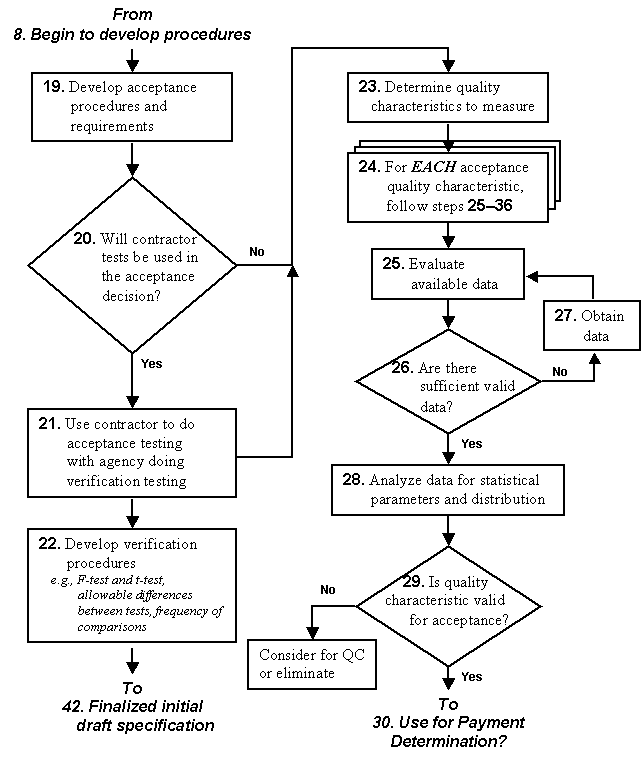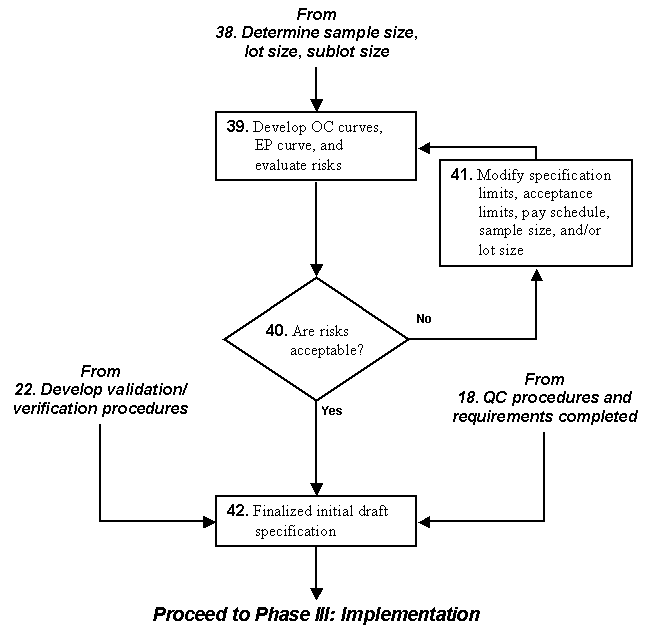U.S. Department of Transportation
Federal Highway Administration
1200 New Jersey Avenue, SE
Washington, DC 20590
202-366-4000
Federal Highway Administration Research and Technology
Coordinating, Developing, and Delivering Highway Transportation Innovations
 |
| This report is an archived publication and may contain dated technical, contact, and link information |
|
Publication Number: FHWA-RD-02-095 |
Quality Assurance (QA) acceptance plans are being used or developed by about 90 percent of State Highway Agencies (SHAs) and most Federal transportation agencies. This has been an ongoing, evolutionary process. This evolution has taken place over several decades and has led to much-improved acceptance plans over those used in the past. The genesis of the move toward QA began in 1956 with the American Association of State Highway Officials (AASHO) Road Test, and the analyses that emanated from that historic study. (1) The unsuspected discovery of the large magnitude of the variability in materials and construction led to the conclusion that specifications must be improved. This, in turn, led to the first step in the evolution of QA specifications and acceptance plans. Prior to the AASHO Road Test, with few exceptions, specifications were materials and methods specifications, sometimes called "prescription" or "recipe" specifications.
The first forms of QA specifications were called statistically oriented specifications or statistically based specifications. These evolved into more modern QA specifications that stress the need to separate quality control (QC) from acceptance. The evolution is now emphasizing the need for performance-related specifications (PRS) that not only describe the desired levels of selected quality characteristics, but also employ quantified relationships containing these characteristics to predict subsequent pavement performance. (2)
The description of the evolution of QA and PRS specifications is well documented in National Cooperative Highway Research Program (NCHRP) Synthesis 38, "Statistically Oriented End-Result Specifications," (3) NCHRP Synthesis 65, "Quality Assurance," (4) and NCHRP Synthesis 212, "Performance-Related Specifications for Highway Construction and Rehabilitation." (5) These syntheses provide an excellent history for the reader interested in how and when QA specifications evolved.
There are two particularly important sources for identifying definitions and terminology associated with QA specifications. The first of these is the Transportation Research Board (TRB) Transportation Research Circular Number E-C037, "Glossary of Highway Quality Assurance Terms," (2) which provides a comprehensive glossary of definitions and terminology. This document is referred to in this manual as the "TRB glossary." The second important source for definitions and terminology is the FHWA Federal-Aid Policy Guide, 23 CFR 637B, "Quality Assurance Procedures for Construction." (6) This document is referred to in this manual as "FHWA 23 CFR 637B."
It is very important to have a clear understanding of the terms used in this manual. To facilitate this understanding, the definitions included in the TRB glossary (2) are used whenever possible. When other sources of definitions are used that differ from those in the TRB glossary, an explanation of the difference is provided.
Definitions Relating to QualityThe TRB glossary (2) includes the following definition for quality:
This definition really indicates that there are three different definitions of quality. These are often referred to as the "level of goodness," "customer satisfaction," and "conformance to requirements" definitions. From a contractor's perspective, the conformance to requirements definition is the most appealing since the contractor's primary role is to satisfy the specification requirements. However, if the specification is not written in the proper manner, meeting the specification requirements may not meet the customer's expectations and therefore may not satisfy the customer. It is therefore important that the specifications be written in such a manner that meeting them will lead to a satisfied customer.
One way to develop specifications that will satisfy the customer, whether customer is defined as the highway agency or the driving public, is to identify the properties that are desired in the final product. In this sense, the term "property" might be thought of as a generic attribute such as strong, durable, or smooth. These properties must be translated into some measurable characteristic that can then be specified and tested to determine conformance. The TRB
glossary (2) defines "quality characteristic" as follows:
Under the above definition, there is a difference between a "property" and a "quality characteristic." There is also a difference between a "quality characteristic" and a "test method." For example, for hot-mix asphalt concrete (HMAC) pavement, the desired "property" might be durability. A "quality characteristic" related to durability might be "asphalt content." The "test method" to obtain this quality characteristic measurement might be the ignition oven. Throughout this manual the term "quality characteristic" is used whenever reference is made to a value that is measured for either quality (process) control purposes or to assess product acceptability. However, in practice, the term property is often used interchangeably with quality characteristic.
Definitions Relating to SpecificationsTraditionally, highway specifications spelled out in detail the work that was to be done by the contractor. These types of specifications are described in the following TRB glossary (2) definition:
The results from the AASTHO Road Test helped to begin a trend towards more testing to evaluate highway materials and construction. Their high personnel requirements, along with the shrinking personnel resources of many highway agencies, also contributed to a move away from materials and methods specifications in favor of more testing of the final product. The TRB glossary (2) includes the following definition:
In practice, current specifications are neither solely "materials and methods" nor "end result." The TRB glossary (2) defines "quality assurance specifications" as follows:
From the above definition it can be seen that a QA specification consists of
two separate functions-quality control or process control, and acceptance. Both
of these major functions are addressed in detail in subsequent chapters. The
TRB glossary (2) contains the following definitions:
By these definitions, therefore, QA is a combination of QC and acceptance.
These definitions also indicate the fundamental separation of QC and acceptance. QC should be used for control of the process. Acceptance should be used to assess the quality of the product and, when appropriate, establish payment. These functions should not be determined by whether the contractor or the agency performs the tests, but instead by the purpose of the test. Thus, in a QA program, the contractor is responsible for QC and, as will be discussed, may also be responsible for performing acceptance tests. If the contractor is responsible for both testing functions, they should continue to be separated. One way, but not the only way, that has been used to make this separation more distinct, in application, is to use acceptance functions, not QC functions, in the determination of payment. However, some acceptance procedures may employ screening tests (see chapter 6) that may be used for pass/fail decisions rather than for payment determination.
It should be pointed out that the definitions for QC and acceptance contained in FHWA 23 CFR Part 637B (6) differ from those in the TRB glossary. (2) The FHWA 23 CFR 637B (6) definition for quality control is "All contractor/vendor operational techniques and activities that are performed or conducted to fulfill the contract requirements." This definition was adapted from American National Standards Institute (ANSI) standard ANSI 90 and International Organization for Standardization (ISO) standard ISO 9000. Acceptance program is defined as "All factors that comprise the State highway agency's (SHA) determination of the quality of the product as specified in the contract requirements." The definition for QA is similar to that in the TRB glossary. (2)
The goal of a QA specification is to relate the measured quality characteristics to the anticipated performance of the materials or construction. The TRB glossary (2) defines performance-related specifications as follows:
The TRB glossary (2) also includes the following definition:
Based on the above definitions, the term "acceptance plan" could be considered to represent only those functions associated with acceptance, with QC thought of as a separate function. However, a broader interpretation of the term might include QC activities as well as acceptance testing since they could both be viewed as part of the process for "evaluating the lot of material or construction." In this manual, the term acceptance plan is used in the narrower sense of relating to only the acceptance decision. The term "QA specification" is used to represent the combined acceptance and QC procedures, as well as other features such as verification and dispute resolution procedures.
The TRB glossary (2) goes on to define two general types of acceptance plans:
The acceptance plans in this manual are based, for the most part, on the variables approach.
The acceptance plan may be a special provision, or part of a supplemental or standard specification. Typically, a new acceptance plan is first employed as a special provision before becoming a part of a supplemental specification and, finally, becoming part of a standard specification.
A primary intent of this manual is, through the use of proper, well-established analytical tools, to demonstrate how effective QC procedures and acceptance plans can be incorporated into QA specifications that are fair to both the contractor and to the agency. The examples used in this manual are directed to those most appropriate for control and acceptance of HMAC and PCC.
The overall specification development and implementation process can be divided into three primary phases:
The steps in each of these phases can be represented in the form of a flowchart for each phase. This manual presents and discusses the steps in each of the three phases of the overall specification development and implementation process. Flowcharts for the overall specification development and implementation process are shown in figures 1 through 3. Specific sections of these flowcharts are presented again to support the detailed discussions of each phase that are presented in upcoming chapters. Phase I is addressed in chapter 2. Phase II is covered in chapters 3 through 7. Phase III is presented in chapter 8. Chapter 9 presents some case studies of the implementation of QA specifications.
 |
| Figure 2. Flowchart for Phase II-Specification Development |

Figure 2. Flowchart for Phase II-Specification Development (continued)

Figure 2. Flowchart for Phase II-Specification Development (continued)

Figure 2. Flowchart for Phase II-Specification Development (continued)